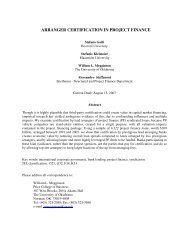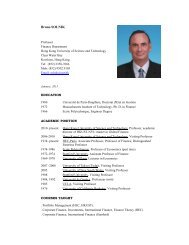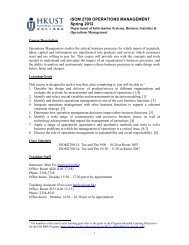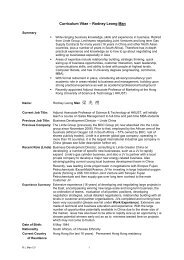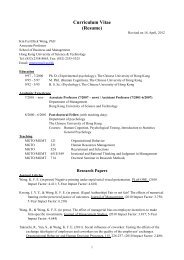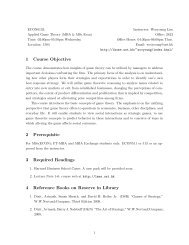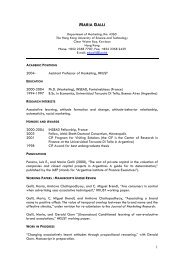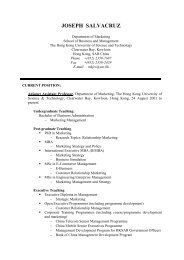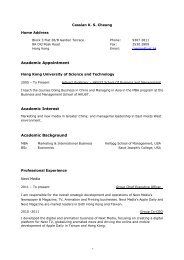Department of Finance FINA 3504: Management of Financial ...
Department of Finance FINA 3504: Management of Financial ...
Department of Finance FINA 3504: Management of Financial ...
Create successful ePaper yourself
Turn your PDF publications into a flip-book with our unique Google optimized e-Paper software.
<strong>Department</strong> <strong>of</strong> <strong>Finance</strong><br />
<strong>FINA</strong> <strong>3504</strong>: <strong>Management</strong> <strong>of</strong> <strong>Financial</strong> Institutions<br />
Fall Semester 2011<br />
Lecturer:<br />
Pr<strong>of</strong>. Jonathan A. Batten<br />
Room 5472, <strong>Department</strong> <strong>of</strong> <strong>Finance</strong><br />
Office: +852-2358-8202<br />
Fax: +852-2358-1749<br />
Email: jabatten@ust.hk<br />
http://www.bm.ust.hk/fina/staff/jabatten.html<br />
Office Hours: Wednesday/Friday 13:30 – 14:30<br />
(before class-other times by appointment)<br />
Teaching Assistant:<br />
Mr. Colin Lee<br />
Email: colinlee@ust.hk<br />
Office Hours: TBA<br />
Lectures: Monday L1 (16:30-17:50) and Friday L1 (12:00-13:20) Room 2406 (Access via<br />
lift 17-18)<br />
Reuters Lab Times:<br />
a) Monday October 10 th , 2011 16:30-17:50 (Introduction) and Friday October 28th, 2011<br />
12:00-13:20 (Charting Tools). The Lab sessions comprise an introduction to the Thomson-<br />
Reuters pricing system and is held in lieu <strong>of</strong> the Monday and Friday lecture (respectively held<br />
on the above dates). The <strong>Financial</strong> Lab is managed by Ms. Gina Kao (ginakao@ust.hk)<br />
b) The Lab will be available for exclusive use by <strong>FINA</strong> <strong>3504</strong> students at a time to be<br />
advised.<br />
Course Outline<br />
The key focus <strong>of</strong> <strong>Finance</strong> <strong>3504</strong> is on managing return and risk in modern financial<br />
institutions (FI). The central theme is that the risks faced by financial institutions managers<br />
and the methods and markets through which these risks are managed are becoming<br />
increasingly similar whether an institution is chartered as a commercial bank, a savings bank,<br />
an investment bank, or an insurance company.<br />
Although the traditional nature <strong>of</strong> each sector’s product activity is analyzed, a greater<br />
emphasis is placed on new areas <strong>of</strong> activities such as asset securitization, <strong>of</strong>f-balance-sheet<br />
banking, and international banking.<br />
The major theme <strong>of</strong> the course is the measurement and management <strong>of</strong> FI risks. In particular,<br />
although we might categorize or group FIs and label them life insurance companies, banks,<br />
finance companies, and so on, in fact, they face risks that are more common than different.<br />
Specifically, all the FIs described (1) hold some assets that are potentially subject to default<br />
or credit risk and (2) tend to mismatch the maturities <strong>of</strong> their balance sheets to a greater or<br />
lesser extent and are thus exposed to interest rate risk. Moreover, all are exposed to some<br />
degree <strong>of</strong> saver withdrawal or liquidity risk depending on the type <strong>of</strong> claims sold to liability<br />
holders. And most are exposed to some type <strong>of</strong> underwriting risk, whether through the sale <strong>of</strong><br />
1
securities or by issuing various types <strong>of</strong> credit guarantees on or <strong>of</strong>f the balance sheet. Finally,<br />
all are exposed to operating cost risks because the production <strong>of</strong> financial services requires<br />
the use <strong>of</strong> real resources and back-<strong>of</strong>fice support systems.<br />
Course Objectives:<br />
Upon completion <strong>of</strong> this course a student should be able to:<br />
1. Identify the principal assets, liabilities and sources <strong>of</strong> value creation for various<br />
financial institutions<br />
2. Identify and describe the principal risks that financial institutions face and explain<br />
how they go about managing these risks<br />
3. Calculate a financial institutions exposure to currency, interest rate and other market<br />
risks and explain how these risks could be managed<br />
4. Describe and explain recent innovations in financial institutions<br />
5. Explain why and how financial institutions are regulated, included regulations<br />
involving capital adequacy, liquidity, market structure and deposit insurance<br />
6. Describe and explain how investment banks create value<br />
7. Describe the financial markets <strong>of</strong> the Asia-Pacific region and identify the structural<br />
problems that may expose institutions and countries to risk.<br />
Textbook:<br />
“<strong>Financial</strong> Institutions <strong>Management</strong>: A Risk <strong>Management</strong> Approach” by Anthony Saunders<br />
(New York University) and Marcia Millon Cornett (Southern Illinois University –<br />
Carbondale). Edition 6e+(International edition), McGraw-Hill Higher Education 2008.<br />
ISBN: 978-007-126704-5. The most recent edition is 7e.<br />
Note a copy <strong>of</strong> the textbook has been placed on 2-hour closed reserve. PDF’s containing<br />
chapter summaries and all end-<strong>of</strong>-chapter problems will be placed on the LMES system.<br />
Course Content:<br />
PART ONE: Introduction<br />
1 Why Are <strong>Financial</strong> Intermediaries Special?<br />
2 The <strong>Financial</strong> Services Industry: Depository Institutions<br />
3 The <strong>Financial</strong> Services Industry: Insurance Companies<br />
4 The <strong>Financial</strong> Services Industry: Securities Firms and Investment Banks<br />
5 The <strong>Financial</strong> Services Industry: Mutual Funds and Hedge Funds<br />
6 The <strong>Financial</strong> Services Industry: <strong>Finance</strong> Companies<br />
7 Risks <strong>of</strong> <strong>Financial</strong> Intermediation<br />
PART TWO: Measuring Risk<br />
8 Interest Rate Risk I<br />
9 Interest Rate Risk II<br />
10 Market Risk<br />
11 Credit Risk: Individual Loan Risk<br />
12 Credit Risk: Loan Portfolio and Concentration Risk<br />
13 Off-Balance-Sheet Risk<br />
14 Foreign Exchange Risk<br />
15 Sovereign Risk<br />
16 Technology and Other Operational Risks<br />
2
17 Liquidity Risk<br />
PART THREE: Managing Risk<br />
18 Liability and Liquidity <strong>Management</strong><br />
19 Deposit Insurance and Other Liability Guarantees<br />
20 Capital Adequacy<br />
21 Product Diversification<br />
22 Geographic Expansion<br />
23 Futures and Forwards<br />
24 Options, Caps, Floors, and Collars<br />
25 Swaps<br />
26 Loan Sales<br />
27 Securitization<br />
Assessment<br />
1. One Midterm Multiple Choice Exam: Friday 21 th October 2010: worth 20 % (1 hour).<br />
Note a ONE-SIDED A4 page cheat sheet can be brought into the test.<br />
2. Final exam: Date TBA: worth 40 % (2 hour). Note a ONE (both sides) A4 page cheat<br />
sheet can be brought into the final exam. Note that the exam date is not usually<br />
allocated until late October or November so be CAREFUL about booking airfares!<br />
3. Major Group Report (maximum <strong>of</strong> 5-students with cross-class groups allowed): Due<br />
17:00pm Friday 9 th December 2010 by EMAIL: worth 15%. Note a brief overview <strong>of</strong><br />
the report findings will need to be presented in week 13 class (starting Friday<br />
December 2, 2011 and will continue until the following Monday December 5, 2011) –<br />
maximum <strong>of</strong> 15 minutes for the presentation. This presentation will be worth 3 <strong>of</strong> the<br />
available 15 marks. The group report will be a maximum <strong>of</strong> 1200 words and should<br />
follow the style <strong>of</strong> an academic article (introduction, brief overview <strong>of</strong> literaturetheory,<br />
literature-empirical evidence, analysis/discussion, conclusion, references), be<br />
12 points font Times Roman. Late submissions will automatically be penalised 5marks<br />
for 1-day late, 8-marks for 2-days late, 10-marks for 3-days late, 11-marks for<br />
4-days late and 12-marks for 5-days late. Submissions later than 5-days will receive<br />
no marks at all.<br />
Report Topic: “Recent articles investigating financial market development highlight<br />
the interlocking funding relationships between corporations, banks and governments.<br />
Investigate the international OR domestic asset and liability positions <strong>of</strong> Asia-Pacific<br />
(non-Japan) banks generally (i.e. from a regional or specific country (China, Thailand<br />
etc. perspective). Where possible discuss any currency and maturity mismatches that<br />
may be evident (termed the “double mismatch” problem) and the implications that<br />
this may have for banking regulation and financial market development more<br />
generally. Can you <strong>of</strong>fer any solutions to the problems that arise? In conclusion<br />
discuss what is critical for the next stage <strong>of</strong> financial market development <strong>of</strong> the Asia-<br />
Pacific market that is investigated. Explain your answer using specific examples <strong>of</strong><br />
policy that could be adopted by governments in the region”. An example <strong>of</strong> a study on<br />
the internationalisation <strong>of</strong> Japanese banks using BIS data will be provided later in the<br />
course. An example <strong>of</strong> policy implementation may be the granting <strong>of</strong> foreign bank<br />
3
licences, the establishment <strong>of</strong> a corporate bond market, or infrastructure such as<br />
trading and clearing technology.<br />
4. Group assignment on bond switching (liability strategies) using the Reuters Modelling<br />
s<strong>of</strong>tware. (Note you should use the same group as in 3.) The assignment is worth<br />
10%. You will first be required to attend a Workshop (Monday 10 th October 2011) in<br />
the <strong>Financial</strong> Laboratory to learn and then utilize the Thomson-Reuters Fixed Income<br />
system. An introduction to the Trading Game will also be provided. After this<br />
Workshop a group assignment will need to be completed. The assignment must be<br />
submitted by 17:00pm on the Monday 7 th November, 2011. Late assignments will not<br />
be accepted. (To ensure pricing is current specific details will be provided in Week 4).<br />
5. Group Trading Game Project 10%. Details will be provided later in the first <strong>Financial</strong><br />
Laboratory Workshop. It is recommended that Groups also attend a Trading Game<br />
and Charting Tools Workshop on Friday October 28, 2011 held in the <strong>Financial</strong><br />
Laboratory. The Game will run from October 17, 2011 to November 28, 2011 (6weeks).<br />
The Game involves currency trading based on REAL-TIME prices from the<br />
market. A short trading report will be completed and submitted by 17:00pm on the<br />
Friday 2 December 2011 (by email).<br />
6. Class Participation Mark 5%. Note a class roll will be taken at random times during<br />
the semester and will contribute to this score. Students will be asked questions based<br />
on the set homework questions. Please review these questions prior to class to avoid<br />
embarrassment.<br />
The course will comprise various topics that will be delivered over the 14 week period<br />
2/9/2010 to 9/12/2010. Note the exam period is 12-21 th December and usually <strong>FINA</strong> <strong>3504</strong><br />
exams are held at the END <strong>of</strong> the Exam Period. If students need to travel prior to the end <strong>of</strong><br />
the exam period they will need to make arrangements to sit a supplementary exam. The<br />
decision as to the time <strong>of</strong> the final and supplementary exam is made by the Administration<br />
and will require a physical presence in Hong Kong.<br />
4
Official Week # Class (Monday) Class (Friday) Review Questions<br />
None‐ but review<br />
events in financial<br />
markets that may<br />
Other Events and Background Reading<br />
Introduction to affect asset prices in Distribution <strong>of</strong> class material and course<br />
Week 1 28/8/2011 ‐<br />
class<br />
the coming week outline<br />
1.1‐1.9, 1.35, 2.1‐ Read about the current regulatory regime<br />
Week 1 5/09/2010 Chapter 1 Chapter 2 2.4,2.9<br />
and how we got there<br />
3.1‐3.5, 4.1‐4.8, 5.1‐ Understand central bank monetary policy in<br />
Week 2 12/09/2010 Chapter 3/4 Chapter 5 5.5, 5.13<br />
civil and common law countries<br />
Understand term structure <strong>of</strong> interest rates<br />
Week 3 19/09/2010 Chapter 6 Chapter 7 6.1‐6.5, 7.1‐7.6, 7.21<br />
8.1‐8.5, 8.12, 8.18, 9.1,<br />
and the current shape <strong>of</strong> the US$ yield curve<br />
Week 4 26/09/2010 Chapter 8 Chapter 9 9.2, 9.17<br />
10.1‐10.5<br />
11.1,<br />
Understand the basics <strong>of</strong> bond pricing<br />
11.5,11.14,11.18, Note National Day Holiday Wednesday<br />
Week 5 3/10/2010 Chapter 10 Chapter 11 11.19<br />
5/10/2011.<br />
<strong>Finance</strong> Lab 1:<br />
Understand the basics <strong>of</strong> portfolio trading <strong>of</strong><br />
Session 10/10<br />
securities (i.e. bonds + equities).<br />
(Introduction to<br />
12.1‐12.4, 12.6, <strong>Finance</strong> Lab booking‐ please contact Gina<br />
Week 6 10/10/2010 the system) Chapter 12 12.16,12.22<br />
Kao (ginakao@ust.hk)<br />
Trading Game Commences (17/10/11)<br />
13.1‐13.2, 13.10, 1‐hour MC Test Friday 21st October (20‐<br />
MIDTERM Test 13.12,<br />
marks).<br />
Week 7 17/10/2010 Chapter 13/14 Chapters 1‐11 14.1‐14.4<br />
Note the Test will be run by Mr. Colin Lee.<br />
Understand how bonds, currencies and<br />
MIDTERM TEST <strong>Finance</strong> Lab 2:<br />
derivatives are traded in financial markets.<br />
SOLUTIONS AND Session 28/10<br />
<strong>Finance</strong> Lab booking‐ please contact Gina<br />
Week 8 24/10/2010 DISCUSSION (Charting Tools)<br />
Kao (ginakao@ust.hk)<br />
Week 9 31/10/2010 Chapter 15 Chapter 16, 17 15.1‐15.5,<br />
5
Week 10 07/11/2010 Chapter 18, 19 Chapter 20<br />
16.1‐16.3, 17.1‐4,<br />
17.11,<br />
18.1‐18.3<br />
19.1, 19.4, 19.5‐19.7,<br />
20.1‐20.4<br />
21.1‐21.4, 22.1‐22.5,<br />
Week 11 14/11/2010 Chapter 21/22 Chapter 23/24 23.1‐23.4, 24.1‐24.6<br />
Week 12 21/11/2010 Chapter 25 Chapter 26 25.1‐25.5, 26.1‐26.3<br />
Week 13 28/11/2010 Chapter 27 Presentations 27.1‐27.6<br />
Week 14 05/12/2010<br />
Remaining Group<br />
Presentations and<br />
Review<br />
Exams scheduled<br />
for 12‐21<br />
STUDY BREAK<br />
Week 15 12/12/2010 December<br />
Week 16 19/12/2010 Exams Scheduled<br />
Exam 11‐21 December (40 marks), Midterm Multiple Choice 1‐Hour test (20 marks)<br />
Reuters Lab Project (10 marks), Group Project <strong>Financial</strong> Markets (15 marks)<br />
Trading Game (10 marks), Class Participation (5 marks)<br />
Reuters Lab Project Due Monday 7th<br />
November (10 marks)<br />
Note: Derivative products will not be<br />
discussed in detail<br />
Note: Securitisation will not be discussed in<br />
detail. Group Project Presentations start<br />
Friday 2/12/2011 and continue (if necessary<br />
to the following Monday). 15‐minute time<br />
slots will be allocated (by lottery) to each<br />
group prior to the class.<br />
Trading Game Report due Friday December<br />
2, 2011.<br />
Group Project Presentations Monday<br />
5/12/2011 and Exam Hints. Study Break 8‐<br />
10 December<br />
Group Project Due (Email) Friday 09<br />
December (15 marks)<br />
6
IT WOULD BE VERY, VERY HELPFUL (ESPECIALLY FOR CLASS<br />
PARTCIPATION MARKS) IF STUDENTS PROVIDED A PHOTO (CAN BE A<br />
PHOTO COPY) WITH NAME AND ID ON A CARD AS FOLLOWS:<br />
7




